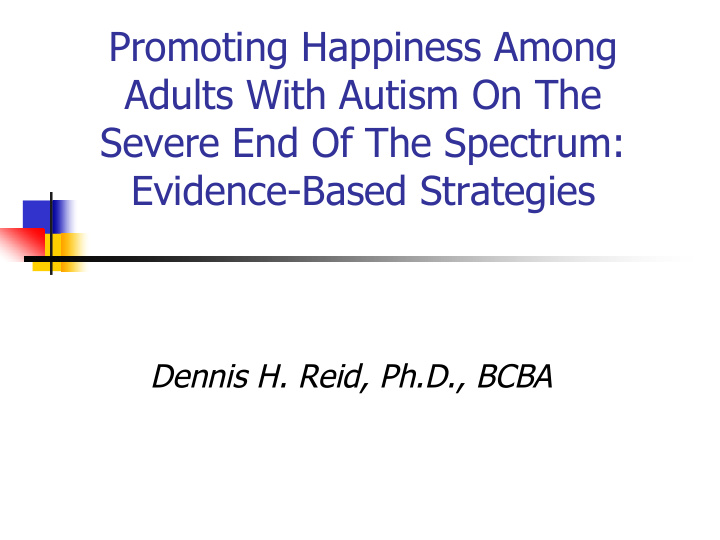



Promoting Happiness Among Adults With Autism On The Severe End Of The Spectrum: Evidence-Based Strategies Dennis H. Reid, Ph.D., BCBA
Why Focus on Happiness? n Pursuit of happiness is a fundamental right n Happiness a primary concern of family members n Reductions in problem behavior
Evidence Base n LITERATURE REVIEWS n Dillon & Carr (2007). Assessing indices of happiness and unhappiness in individuals with developmental disabilities. Behavioral Interventions, 22, 229-244. n Reid & Green (2006). Life enjoyment, happiness, and antecedent behavior support. In J.K. Luiselli (Ed.), Antecedent assessment & intervention. (pp. 249-268). Baltimore, Brookes Publishing. n More later . . .
In Some Ways, Happiness a Risky Venture in ABA n A private event n Usually measured by verbal report – can be risky n Verbal reports very difficult for people who lack vocal communication n Still, happiness is viewed by society as important . . . n For people with intellectual disabilities, it should not be taken for granted; it should be targeted and addressed like any other desired outcome
Qualifications n Happiness on day-to-day basis vs. major lifestyle changes n Focus on happiness and personal growth n That is, not in place of personal growth
Evidence-Based Protocol to Promote Happiness n Identify indices of happiness and unhappiness n Validate identified indices n Act to increase situations accompanied by happiness indices n Act to decrease situations accompanied by unhappiness indices n Monitor and evaluate routinely
Identifying Indices of Happiness and Unhappiness n Common indices n Happiness: smiling, laughing, yelling while smiling n Unhappiness: frowning, grimacing, crying, yelling without smiling Qualification for people with severe disabilities
Identifying Happiness Indices: Caregiver Opinion n Common practice n Concerns with validity n To promote validity: n Ensure familiarity of caregivers n Obtain caregiver consensus
Identifying Happiness Indices: Preference Assessments n How preference assessments relate to indices of happiness and unhappiness
Validating Happiness and Unhappiness Indices n Identify situations in which a person usually experiences happiness and unhappiness n Observe indices in above situations n Compare occurrence of indices across situations n Provide repeated choices
REFERENCE Identifying and Validating Indices of Happiness and Unhappiness among Adults with Autism (and severe intellectual disabilities) Parsons, M. B., Reid, D. H., Bentley, E., Inman, A., & Lattimore, L. P. (2012). Identifying indices of happiness and unhappiness among adults with autism: Potential targets for behavioral assessment and intervention. Behavior Analysis in Practice,5, 15-25 www.abainternational.org
Increasing Happiness n The importance of personal relationships n Role of familiarity of staff n Preferred vs. nonpreferred status of staff
Familiarizing New Staff for Working with Adults Severe Disabilities: A Case for Relationship Building Parsons, M.B., Bentley, E., Solari, T., & Reid, D.H. (in press). Behavior Analysis in Practice
Purpose n Evaluate effects of familiar vs. unfamiliar staff on behavior of adults with autism on severe end of spectrum n Evaluate effects of a familiarization process for new staff
General Procedures n Setting (work focus) n Participants 4 men with features of autism on the severe end of the n spectrum n DVs: happiness and unhappiness indices, compliance, problem behavior, on task n Familiarization program: fun time and phase-in
Familiar Experienced Staff and Unfamiliar Experienced Staff 100 Percentage of Instructions with Participant Compliance ● ● Familiar ○ ○ Unfamiliar S1 80 S2 60 40 Participant Mr. Lutz 20 0 1 2 3 4 5 6 7 8 100 S3 80 60 S4 Participant 40 Mr. Fox 20 0 1 2 3 4 5 6 7 8 Observation Sessions
Developing a Relationship: Summary n Spend time doing things that the person likes to do n Fun Time Program n Establish familiarity (phase-in) n Occurrence of happiness indices during interactions suggests a good relationship
Increasing Happiness n The power of pleasant social attention n Impact on some problem behavior
Increasing Happiness n Providing individual choices n Choice opportunities must be provided based on individual skill level for responding with a meaningful choice
LICS
Increasing Happiness n Accessing preferences n Two-step process n 1) identify individual preferences n 2) embed in daily activities n Initial procedure to reduce problem behavior
Increasing Happiness by Reducing Unhappiness n Rationale: continuum of happiness and unhappiness n Impact on some problem behavior n Process n Identify situation with unhappiness indices n Eliminate the situation if possible n Alter the situation
Making Undesired Activities More Enjoyable: Example n Preference-Based Teaching n Reid & Green (2005) www.behaviordevelopmentsolutions.com n n Rationale n Some learners engage in challenging behavior to escape or avoid teaching programs n If teaching programs are fun, no need for challenging behavior
To Effectively Promote Happiness . . . n Happiness should be a goaled, desired outcome just like more traditional outcomes n Must have behavioral objectives for monitoring and increasing/maintaining happiness (indices) n Informally, how often do we see individuals happy and unhappy?
Don’t Forget Support Staff n It is unlikely staff will effectively promote consumer happiness if staff are frequently discontented with their work environment
Reference for Increasing Happiness n Reid, D.H. (2016). Promoting Happiness Among Adults with Autism and Other Severe Disabilities: Evidence-Based Strategies. n www.behaviordevelopmentsolutions.com
n Contact: n Denny Reid; drhmc@vistatech.net
Recommend
More recommend